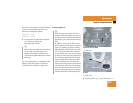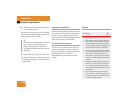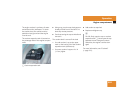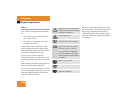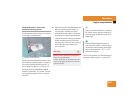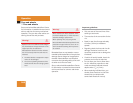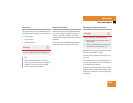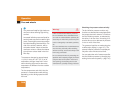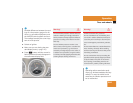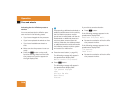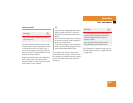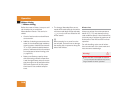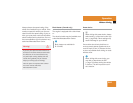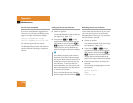
265
Operation
Tires and wheels
̈ Switch on ignition.
̈ Make sure you are viewing the stan-
dard display menu (
୴ page 127).
̈ Press k button until the current in-
flation pressures for each tire appear in
the tachometer display field.
i
Possible differences between the read-
ings of a tire pressure gauge of an air
hose, e.g. gas station equipment, and
the vehicle’s control system can occur.
The readings issued by the control sys-
tem are more precise.
Warning! G
The tire inflation pressure monitor does not
indicate a warning for wrongly selected in-
flation pressures. Always adjust tire inflation
pressure according to the label on the fuel
filler flap.
The tire inflation pressure monitor is not
able to issue a warning due to a sudden dra-
matic loss of pressure (e.g. tire blowout
caused by a foreign object). In the event of
a sudden loss of pressure, bring the vehicle
to a halt by carefully applying the brakes and
avoiding abrupt steering maneuvers.
Warning! G
Follow recommend tire pressures.
Do not overinflate tires. Overinflating tires
can result in sudden deflation (blowout) be-
cause they are more likely to become punc-
tured or damaged by road debris, potholes,
etc.
Do not underinflate tires. Underinflated tires
wear unevenly, adversely affect handling
and fuel economy, and are more likely to fail
from being overheated.
Do not overload the tires by exceeding the
specified vehicle capacity weight (as indicat-
ed by the label on the pillar in the driver’s
door opening). Overloading the tires can
overheat them, possibly causing a blowout.
i
Operating radio transmission equip-
ment (e.g. wireless headsets, two-way
radios) in or near the vehicle could
cause the tire inflation pressure moni-
tor to malfunction.



